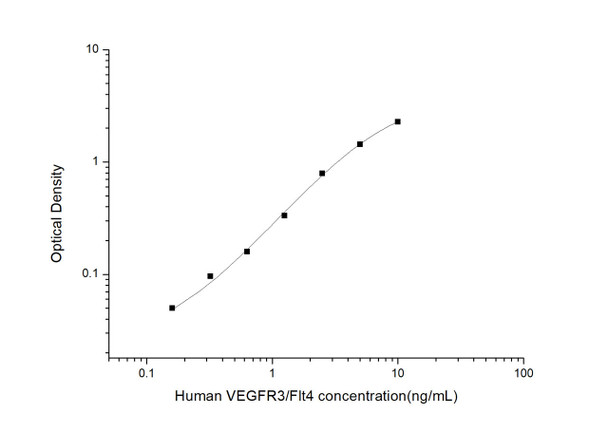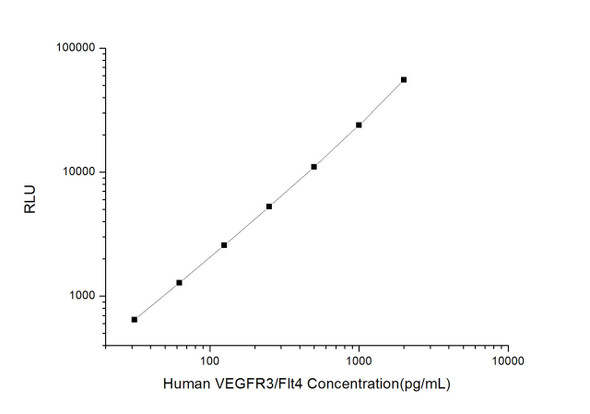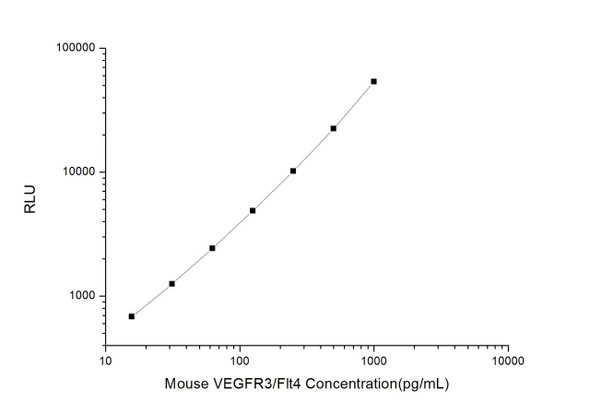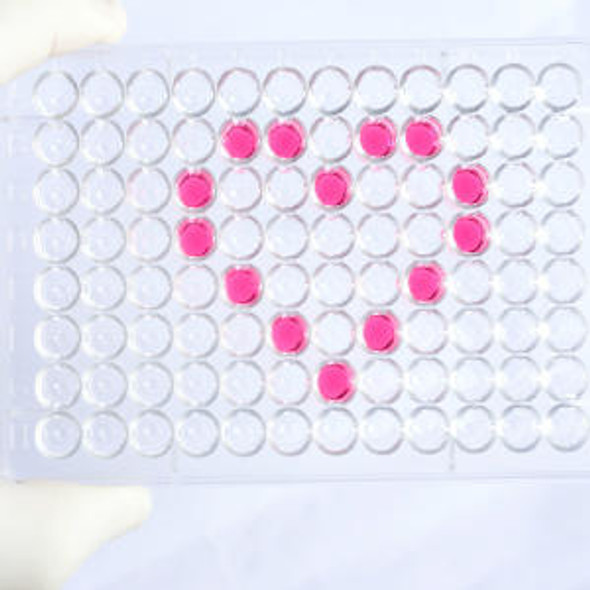Human Cardiovascular ELISA Kits
Human VEGFR3/Flt4 (Vascular Endothelial Cell Growth Factor Receptor 3) ELISA Kit (HUES03066)
- SKU:
- HUES03066
- Product Type:
- ELISA Kit
- Size:
- 96 Assays
- Uniprot:
- P35916
- Sensitivity:
- 0.09ng/mL
- Range:
- 0.16-10ng/mL
- ELISA Type:
- Sandwich
- Synonyms:
- FLT41, PCL, LMPH1A
- Reactivity:
- Human
- Sample Type:
- Serum, plasma and other biological fluids
- Research Area:
- Cardiovascular
Description
| Assay type: | Sandwich |
| Format: | 96T |
| Assay time: | 4.5h |
| Reactivity: | Human |
| Detection Method: | Colormetric |
| Detection Range: | 0.16-10 ng/mL |
| Sensitivity: | 0.10 ng/mL |
| Sample Volume Required Per Well: | 100µL |
| Sample Type: | Serum, plasma and other biological fluids |
| Specificity: | This kit recognizes Human VEGFR3/Flt4 in samples. No significant cross-reactivity or interference between Human VEGFR3/Flt4 and analogues was observed. |
This ELISA kit uses Sandwich-ELISA as the method. The micro ELISA plate provided in this kit has been pre-coated with an antibody specific to Human VEGFR3/Flt4. Standards or samples are added to the appropriate micro ELISA plate wells and combined with the specific antibody. Then a biotinylated detection antibody specific for Human VEGFR3/Flt4 and Avidin-Horseradish Peroxidase (HRP) conjugate are added to each micro plate well successively and incubated. Free components are washed away. The substrate solution is added to each well. Only those wells that contain Human VEGFR3/Flt4, biotinylated detection antibody and Avidin-HRP conjugate will appear blue in color. The enzyme-substrate reaction is terminated by adding Stop Solution and the color turns yellow. The optical density (OD) is measured spectrophotometrically at a wavelength of 450 nm ± 2 nm. The OD value is proportional to the concentration of Human VEGFR3/Flt4. The concentration of Human VEGFR3/Flt4 in samples can be calculated by comparing the OD of the samples to the standard curve.
| UniProt Protein Function: | VEGFR3: Tyrosine-protein kinase that acts as a cell-surface receptor for VEGFC and VEGFD, and plays an essential role in adult lymphangiogenesis and in the development of the vascular network and the cardiovascular system during embryonic development. Promotes proliferation, survival and migration of endothelial cells, and regulates angiogenic sprouting. Signaling by activated FLT4 leads to enhanced production of VEGFC, and to a lesser degree VEGFA, thereby creating a positive feedback loop that enhances FLT4 signaling. Modulates KDR signaling by forming heterodimers. The secreted isoform 3 may function as a decoy receptor for VEGFC and/or VEGFD and play an important role as a negative regulator of VEGFC-mediated lymphangiogenesis and angiogenesis. Binding of vascular growth factors to isoform 1 or isoform 2 leads to the activation of several signaling cascades; isoform 2 seems to be less efficient in signal transduction, because it has a truncated C-terminus and therefore lacks several phosphorylation sites. Mediates activation of the MAPK1/ERK2, MAPK3/ERK1 signaling pathway, of MAPK8 and the JUN signaling pathway, and of the AKT1 signaling pathway. Phosphorylates SHC1. Mediates phosphorylation of PIK3R1, the regulatory subunit of phosphatidylinositol 3- kinase. Promotes phosphorylation of MAPK8 at 'Thr-183' and 'Tyr- 185', and of AKT1 at 'Ser-473'. Interacts with VEGFC and VEGFD. Monomer in the absence of bound VEGFC or VEGFD. Homodimer in the presence of bound VEGFC or VEGFD. Can also form a heterodimer with KDR. Interacts with PTPN14; the interaction is enhanced by stimulation with VEGFC. Interacts with CRK, GRB2, PTK2/FAK1, SHC1, PIK3R1 and PTPN11/SHP- 2. Identified in a complex with SRC and ITGB1. Detected in endothelial cells. Widely expressed. Detected in fetal spleen, lung and brain. Detected in adult liver, muscle, thymus, placenta, lung, testis, ovary, prostate, heart, and kidney. Present in an inactive conformation in the absence of bound ligand. Binding of VEGFC or VEGFD leads to dimerization and activation by autophosphorylation on tyrosine residues. Inhibited by MAZ51. Belongs to the protein kinase superfamily. Tyr protein kinase family. CSF-1/PDGF receptor subfamily. 3 isoforms of the human protein are produced by alternative splicing. |
| UniProt Protein Details: | Protein type:EC 2. 7. 10. 1; Kinase, protein; Membrane protein, integral; Protein kinase, TK; Protein kinase, tyrosine (receptor); TK group; VEGFR family Chromosomal Location of Human Ortholog: 5q35. 3 Cellular Component: plasma membrane; receptor complex Molecular Function:growth factor binding; protein binding; protein phosphatase binding; transmembrane receptor protein tyrosine kinase activity; vascular endothelial growth factor receptor activity Biological Process: blood vessel morphogenesis; lymph vessel development; lymphangiogenesis; negative regulation of apoptosis; peptidyl-tyrosine phosphorylation; positive regulation of cell proliferation; positive regulation of endothelial cell proliferation; positive regulation of JNK cascade; positive regulation of MAPKKK cascade; positive regulation of protein amino acid phosphorylation; protein amino acid autophosphorylation; sprouting angiogenesis; transmembrane receptor protein tyrosine kinase signaling pathway; vascular endothelial growth factor receptor signaling pathway; vasculature development Disease: Hemangioma, Capillary Infantile; Lymphedema, Hereditary, Ia |
| NCBI Summary: | This gene encodes a tyrosine kinase receptor for vascular endothelial growth factors C and D. The protein is thought to be involved in lymphangiogenesis and maintenance of the lymphatic endothelium. Mutations in this gene cause hereditary lymphedema type IA. [provided by RefSeq, Jul 2008] |
| UniProt Code: | P35916 |
| NCBI GenInfo Identifier: | 357529070 |
| NCBI Gene ID: | 2324 |
| NCBI Accession: | P35916. 3 |
| UniProt Secondary Accession: | P35916,Q16067, Q86W07, Q86W08, A8K6L4, B5A926, |
| UniProt Related Accession: | P35916,AAB23636 |
| Molecular Weight: | 153kDa |
| NCBI Full Name: | Vascular endothelial growth factor receptor 3 |
| NCBI Synonym Full Names: | fms related tyrosine kinase 4 |
| NCBI Official Symbol: | FLT4 |
| NCBI Official Synonym Symbols: | PCL; FLT-4; FLT41; LMPH1A; VEGFR3; VEGFR-3 |
| NCBI Protein Information: | vascular endothelial growth factor receptor 3 |
| UniProt Protein Name: | Vascular endothelial growth factor receptor 3 |
| UniProt Synonym Protein Names: | Fms-like tyrosine kinase 4; FLT-4; Tyrosine-protein kinase receptor FLT4 |
| Protein Family: | Vascular endothelial growth factor receptor |
| UniProt Gene Name: | FLT4 |
As the OD values of the standard curve may vary according to the conditions of the actual assay performance (e. g. operator, pipetting technique, washing technique or temperature effects), the operator should establish a standard curve for each test. Typical standard curve and data is provided below for reference only.
| Concentration (ng/mL) | O.D | Average | Corrected |
| 10 | 2.342 2.348 | 2.345 | 2.284 |
| 5 | 1.492 1.496 | 1.494 | 1.433 |
| 2.5 | 0.865 0.843 | 0.854 | 0.793 |
| 1.25 | 0.391 0.397 | 0.394 | 0.333 |
| 0.63 | 0.235 0.205 | 0.22 | 0.159 |
| 0.32 | 0.162 0.152 | 0.157 | 0.096 |
| 0.16 | 0.105 0.117 | 0.111 | 0.05 |
| 0 | 0.059 0.063 | 0.061 | -- |
Precision
Intra-assay Precision (Precision within an assay): 3 samples with low, mid range and high level Human VEGFR3/Flt4 were tested 20 times on one plate, respectively.
Inter-assay Precision (Precision between assays): 3 samples with low, mid range and high level Human VEGFR3/Flt4 were tested on 3 different plates, 20 replicates in each plate.
| Intra-assay Precision | Inter-assay Precision | |||||
| Sample | 1 | 2 | 3 | 1 | 2 | 3 |
| n | 20 | 20 | 20 | 20 | 20 | 20 |
| Mean (ng/mL) | 0.48 | 1.45 | 3.74 | 0.49 | 1.56 | 3.71 |
| Standard deviation | 0.03 | 0.06 | 0.12 | 0.03 | 0.08 | 0.13 |
| C V (%) | 6.25 | 4.14 | 3.21 | 6.12 | 5.13 | 3.50 |
Recovery
The recovery of Human VEGFR3/Flt4 spiked at three different levels in samples throughout the range of the assay was evaluated in various matrices.
| Sample Type | Range (%) | Average Recovery (%) |
| Serum (n=5) | 87-100 | 92 |
| EDTA plasma (n=5) | 87-101 | 95 |
| Cell culture media (n=5) | 87-99 | 94 |
Linearity
Samples were spiked with high concentrations of Human VEGFR3/Flt4 and diluted with Reference Standard & Sample Diluent to produce samples with values within the range of the assay.
| Serum (n=5) | EDTA plasma (n=5) | Cell culture media (n=5) | ||
| 1:2 | Range (%) | 89-101 | 88-98 | 99-114 |
| Average (%) | 96 | 93 | 104 | |
| 1:4 | Range (%) | 91-103 | 80-90 | 88-100 |
| Average (%) | 98 | 86 | 95 | |
| 1:8 | Range (%) | 90-103 | 87-99 | 84-96 |
| Average (%) | 95 | 92 | 89 | |
| 1:16 | Range (%) | 92-108 | 84-97 | 86-101 |
| Average (%) | 98 | 90 | 92 |
An unopened kit can be stored at 4°C for 1 month. If the kit is not used within 1 month, store the items separately according to the following conditions once the kit is received.
| Item | Specifications | Storage |
| Micro ELISA Plate(Dismountable) | 8 wells ×12 strips | -20°C, 6 months |
| Reference Standard | 2 vials | |
| Concentrated Biotinylated Detection Ab (100×) | 1 vial, 120 µL | |
| Concentrated HRP Conjugate (100×) | 1 vial, 120 µL | -20°C(shading light), 6 months |
| Reference Standard & Sample Diluent | 1 vial, 20 mL | 4°C, 6 months |
| Biotinylated Detection Ab Diluent | 1 vial, 14 mL | |
| HRP Conjugate Diluent | 1 vial, 14 mL | |
| Concentrated Wash Buffer (25×) | 1 vial, 30 mL | |
| Substrate Reagent | 1 vial, 10 mL | 4°C(shading light) |
| Stop Solution | 1 vial, 10 mL | 4°C |
| Plate Sealer | 5 pieces | |
| Product Description | 1 copy | |
| Certificate of Analysis | 1 copy |
- Set standard, test sample and control (zero) wells on the pre-coated plate and record theirpositions. It is recommended to measure each standard and sample in duplicate. Note: addall solutions to the bottom of the plate wells while avoiding contact with the well walls. Ensuresolutions do not foam when adding to the wells.
- Aliquot 100µl of standard solutions into the standard wells.
- Add 100µl of Sample / Standard dilution buffer into the control (zero) well.
- Add 100µl of properly diluted sample (serum, plasma, tissue homogenates and otherbiological fluids) into test sample wells.
- Cover the plate with the sealer provided in the kit and incubate for 90 min at 37°C.
- Aspirate the liquid from each well, do not wash. Immediately add 100µL of BiotinylatedDetection Ab working solution to each well. Cover the plate with a plate seal and gently mix. Incubate for 1 hour at 37°C.
- Aspirate or decant the solution from the plate and add 350µL of wash buffer to each welland incubate for 1-2 minutes at room temperature. Aspirate the solution from each well andclap the plate on absorbent filter paper to dry. Repeat this process 3 times. Note: a microplatewasher can be used in this step and other wash steps.
- Add 100µL of HRP Conjugate working solution to each well. Cover with a plate seal andincubate for 30 min at 37°C.
- Aspirate or decant the solution from each well. Repeat the wash process for five times asconducted in step 7.
- Add 90µL of Substrate Reagent to each well. Cover with a new plate seal and incubate forapproximately 15 min at 37°C. Protect the plate from light. Note: the reaction time can beshortened or extended according to the actual color change, but not by more than 30min.
- Add 50 µL of Stop Solution to each well. Note: Adding the stop solution should be done inthe same order as the substrate solution.
- Determine the optical density (OD value) of each well immediately with a microplate readerset at 450 nm.






